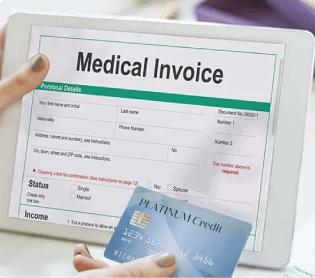Introduction
The healthcare sector is undergoing systematic transformation. Due to the necessity of managing escalating costs, enhancing revenue cycle management, and improving partnerships between payers and providers, healthcare payment solutions are swiftly evolving into a strategic imperative, particularly through advancements in medical billing solutions and healthcare reimbursement solutions.
What was previously a post-payment recovery process, today, payment integrity is the key driver of process simplification across the healthcare reimbursement landscape. Now, as 2025 begins, payers must reduce waste, transition to value-based care, and rebuild provider trust.
The money pressures on providers and health plans are exacerbated by rising regulatory sophistication, expectations of rapid service from patients, and a larger number of claims that need to be accurately adjudicated. With changes in reimbursement strategies, payment integrity is no longer an afterthought back-office activity but a financial sustainability and operational efficiency driver.
Transformation is enabled by technology, workflow, and governance structures but necessitates alignment, transparency, and flexibility to be successful. This article addresses four emerging transitions that are redefining payment integrity in healthcare today.
Putting Providers at the Center of Payment Integrity
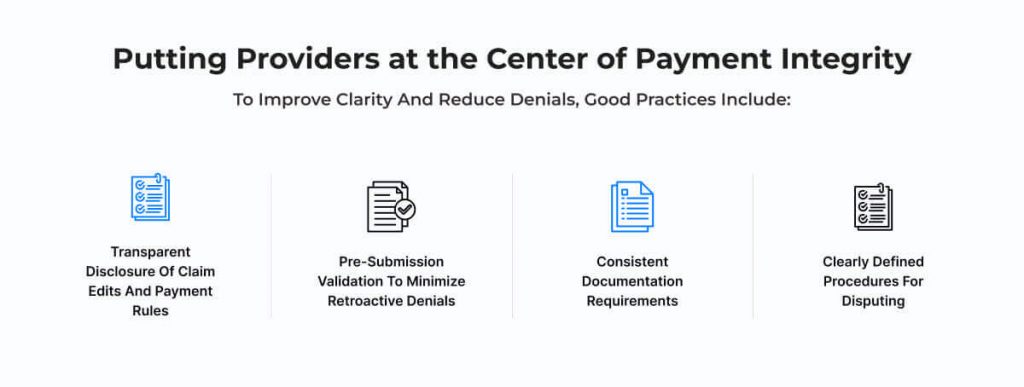
One of the most impactful changes is a shift toward provider-focused strategies. Past claims review had a tendency to generate disputes, rather than clarity, with unclear rules for documentation and inconsistent denials.
To better achieve clarity and collaboration, payment integrity in medical billing solutions needs to prioritize transparency about how claims are examined and paid. Strong denial management in healthcare is also crucial to reduce unnecessary friction between payers and providers.
To improve clarity and reduce denials, good practices include –
- Transparent disclosure of claim edits and payment rules
- Pre-submission validation to minimize retroactive denials
- Consistent documentation requirements
- Clearly defined procedures for disputing
Payment integrity within medical billing, when properly implemented, decreases unnecessary appeals and ensures accurate and timely payments for everyone involved. Establishing joint education sessions between payers and providers on claim adjudication policies and denial rationales can further promote alignment. In addition, feedback loops that provide claim-level explanations and opportunities for real-time clarification can significantly reduce misunderstandings.
Combining Pre-Pay and Post-Pay Strategies
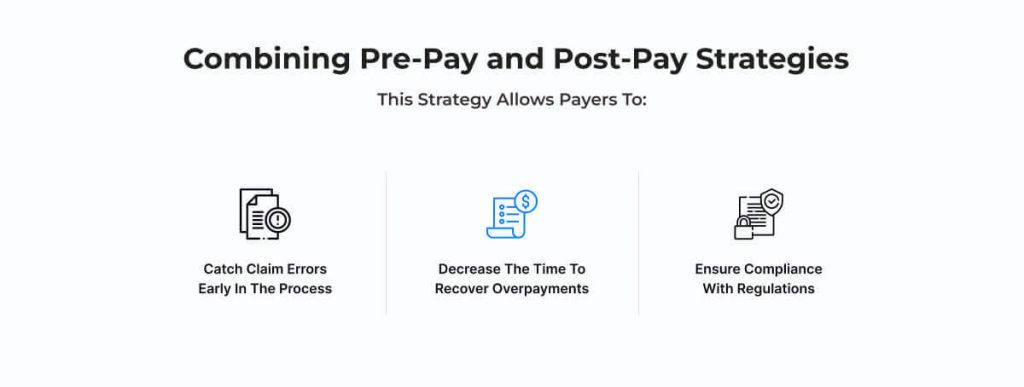
Post-payment audits are still valuable, but no longer sufficient. In 2025, payers are implementing hybrid approaches that combine pre-payment validation and post-payment review.
This strategy allows payers to
- Catch claim errors early in the process
- Decrease the time to recover overpayments
- Ensure compliance with regulations
Flag complex cases for retrospective review.
By incorporating real-time validations, this approach enables more preventative payment integrity and minimizes friction across the medical claims management lifecycle. Integrated healthcare software development plays a critical role in building agile, responsive systems.
This setup enables dynamic flagging of outlier claims without slowing down straightforward ones. By integrating pre-pay analytics and post-pay auditing under a unified governance structure, organizations can also improve resource allocation and identify systemic issues that require process improvements.AI-driven tools like visual intelligence are helping streamline evidence collection and claim assessments, improving payment accuracy and reducing disputes.
Value-Based Model Alignment
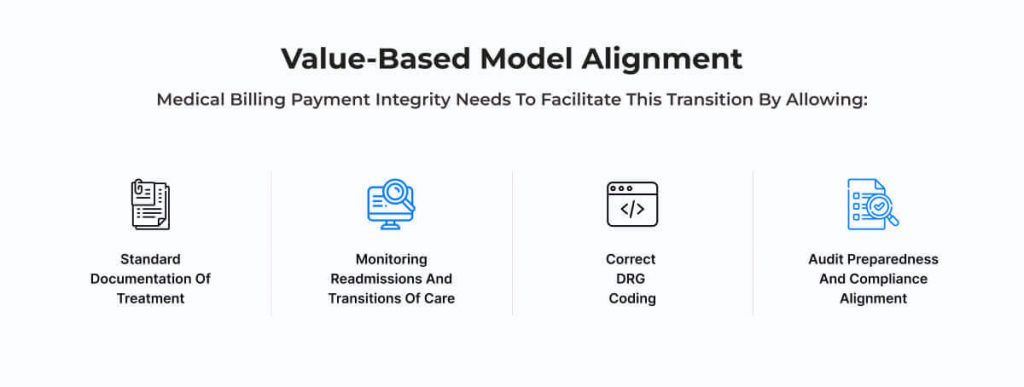
As value-based care grows, payment integrity systems need to adapt to support new coding and documentation complexity.
Diagnosis-Related Groups (DRGs) and other such models bring performance-based payments based on outcomes. Such models necessitate more advanced data gathering, coding accuracy, and outcome monitoring.
Medical billing payment integrity needs to facilitate this transition by allowing
- Standard documentation of treatment
- Monitoring readmissions and transitions of care
- Correct DRG coding
- Audit preparedness and compliance alignment
Software that blends automation with clinical reasoning, such as advanced medical coding solutions and revenue cycle management platforms, will be a necessity to help navigate these sophisticated reimbursement schemes.
Balancing Automation with Human Judgment

Sophisticated software improves precision, but it’s no substitute for human intelligence. Coders, auditors, and compliance specialists have an integral role in examining exceptions, interpreting context, and settling disagreements.
Health plans should manually evaluate complicated or unclear claims. Allow subject matter specialists to customize edits.
This approach bridges medical understanding with rule-based review systems. Produce detailed audit trails for compliance.
While automation boosts efficiency, experienced professionals remain essential to manage exceptions and ensure accuracy. As payer rules and medical policy evolve, staff must stay up to date on clinical guidelines, policy changes, and coding standards such as ICD-10, CPT, and HCPCS. Collaborative review boards, comprised of both clinical and administrative experts, can be used to resolve high-impact disputes or define exception protocols to ensure consistency across departments.
As AI continues transforming claims processing, automation supports staff by handling repetitive tasks and flagging anomalies in real time.
Final Thoughts
The promise of payment integrity lies in integration across technology, processes, and collaboration. For health plans to stay both compliant and effective, they must build systems that are open, adaptive, and responsive to change.
Modern tools are playing a key role in this shift. For example, solutions like Nexar’s dash cams offer real-time video evidence that speeds up First Notice of Loss (FNOL) and simplifies claims adjudication.
OSP’s solutions span the full lifecycle, from claim editing and validation to automated post-payment audits. Designed to ensure accuracy and efficiency, these tools strengthen payer-provider relationships by reducing friction and supporting transparent billing practices.
References
- https://bdeo.io/en/blog/visual-intelligence-management-home-claims/
- https://vlinkinfo.com/blog/how-ai-is-transforming-claims-processing-in-insurance-industry
- https://milled.com/nexar-dash-cams/have-you-heard-about-our-referral-program-BhgKYc-DH-TxZFOS
- https://www.getnexar.com/
OSP is a trusted healthcare software development company that delivers bespoke solutions as per your business needs. Connect with us to hire the best talents in the industry to build enterprise-grade software.
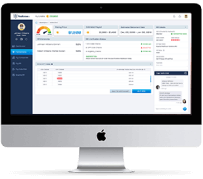
How can we help?
Fill out the short form below or call us at (888) 846-5382
Discuss Your Project Handover with a team of expert Book a free consultation arrow_forward
About Author

Written by Riken Shah linkedin
Riken's work motto is to help healthcare providers use technological advancements to make healthcare easily accessible to all stakeholders, from providers to patients. Under his leadership and guidance, OSP Labs has successfully developed over 600 customized software solutions for 200+ healthcare clients across continents.
















